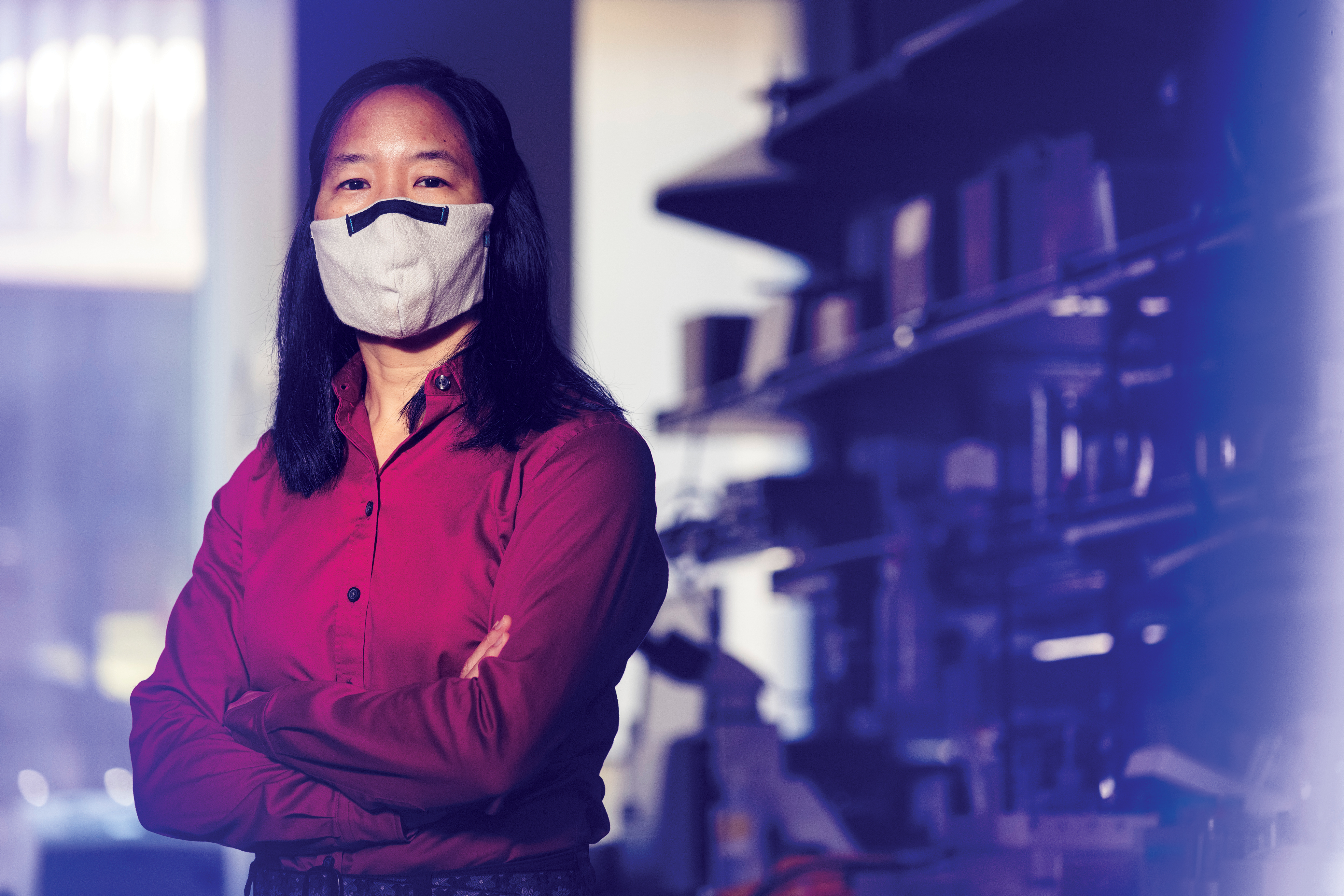“I KNEW THE WHO [WORLD HEALTH ORGANIZATION ] WAS OUT THERE SAYING COVID-19 IS NOT AIRBORNE, SO BECAUSE OF THAT AND THE WIDESPREAD MISUNDERSTANDING OF HOW AIRBORNE SPREAD WORKS,
I KNEW IT WAS IMPORTANT FOR PEOPLE WHO UNDERSTAND IT TO GET THE KNOWLEDGE OUT THERE, AND IT WASN’T GOING TO BE BY READING OUR ACADEMIC PAPERS.”
LINSEY MARR AWOKE TO AN UNUSUALLY full inbox during the July 4, 2020 holiday weekend.
“I had like 20 interview requests in my inbox that morning just over the course of a couple of hours,” said Marr, the Charles P. Lunsford Professor of Civil and Environmental Engineering. “At that point, I reached out to the Virginia Tech Media Relations team for a little help.”
Days earlier, a letter Marr helped write, which was directed to the global medical community and relevant governing bodies, had been made public. Signed by 239 scientists from 32 countries, the letter urged powerful groups, such as the World Health Organization (WHO), to stop downplaying the potential for the airborne spread of COVID-19 during routine activities and to use their platforms to advocate for mitigation strategies.
The bold letter, which was printed in major media publications, including The New York Times, drew worldwide attention. It ultimately helped change the global conversation about how COVID-19 spreads and the types of precautions recommended by groups like the WHO and Centers for Disease Control and Prevention (CDC).
The milestone moment came after Marr spent months advocating through traditional media and social media channels for a better understanding of the deadly virus’ spread. Marr, who has spent more than a dozen years studying the airborne spread of viruses, has now been interviewed hundreds of times, quoted thousands more, and amassed more than 36,000 followers on Twitter since March 2020.
“When I first started researching the airborne spread of viruses, I told my parents, ‘You’ll hear about this someday.’ I knew there was a gaping hole in the academic literature and the misunderstanding was so bad. There was a lot of research to do,” said Marr, now one of only a handful of experts on the topic.
Marr came to Virginia Tech in 2003 after earning her bachelor’s in engineering science from Harvard and her doctorate from the University of California at Berkeley.
It was Marr’s experience placing her children in daycare that first sparked her interest in studying the airborne spread of viruses. When her son continued to catch colds despite the daycare center’s cleaning protocols, Marr decided to figure out the cause.
“I was frustrated, I guess, and really just curious to know more,” she said.
IN THE NEWS
From March 2020 through late February 2021, Linsey Marr was interviewed several hundred times in local, regional, national, and international news coverage. She’s been mentioned roughly 171,000 times in media clips across the globe, including roughly 148,000 in the U.S.
Some of the more notable mentions include:
The New York Times: “Most of us had never heard of aerosol science before the pandemic. Then Virginia Tech’s Linsey Marr showed up and became our tour guide to the invisible world of airborne particles.”
The Times of UK: “Professor Linsey Marr’s hugging rules during the COVID crisis have made her a social media star. The science behind it is deadly serious, she explains.”
The Wall Street Journal: “Linsey Marr is an engineering professor at Virginia Tech who specializes in a field that has never been so useful to so many people: She’s an expert on viruses in the air. Marr’s research during a pandemic driven by airborne transmission of a virus has made her a trusted source of advice for people all over the world. And in her local CrossFit.”
Marr is prolific on Twitter at https://twitter.com/linseymarr.
During the 12 years that followed, Marr has amassed numerous honors. They include a National Institutes of Health New Innovator Award in 2013 and an appointment to a National Academies of Sciences, Engineering, and Medicine board in January.
“To emphasize the relevance of course material to real life, I begin most of my lectures with a news story, and then I try to weave personal connections into the ensuing discussion,” said Marr.
Marr took a similar approach to sharing complex information when she realized the possibility that COVID-19 was being spread by airborne particles wasn’t garnering a lot of attention. In early March, she took to Twitter, sharing what is now a pinned Tweet atop her profile warning of the virus’ airborne transmission. In contrast, the CDC didn’t permanently publish a position accepting the virus could be spread by tiny particles lingering in the air until October.
“I knew the WHO was out there saying COVID-19 is not airborne, so because of that and the widespread misunderstanding of how airborne spread works, I knew it was important for people who understand it to get the knowledge out there, and it wasn’t going to be by reading our academic papers,” Marr said.
Marr had about 3,000 followers when she pinned that tweet in March, and she now has more than 36,000 people following her on the social media platform. There, she’s used the visual of cigarette smoke to explain viral plumes, illustrated mathematically proven safer ways to hug with photos of her and her daughter, and regularly shared practical safety tips for everyday life in the pandemic era.
As a June article in The New York Times said, “Her Twitter feed is a daily exchange of ideas among fellow scientists, and it’s also peppered with questions from followers, which she tries to answer. Part of the reason Dr. Marr has become so popular in public forums is her ability to explain difficult scientific concepts in easy-to-understand terms.”
In July, she was asked by the same newspaper to pen an op-ed. In November the ventilation measures she helped the gym she attends put in place gained national attention when 50 athletes were potentially exposed to the virus but none contracted COVID-19.
“If you start a research project, and it takes you at least six months to a year to complete it, then another six months to publish. Sometimes, two years have passed before you really share [the project’s findings],” Marr said. “With the pandemic, we don’t have that kind of time, so there’s been a lot of good discussions on Twitter, as well as getting those critical messages to the public.”
According to Pamela VandeVord, associate dean for research and graduate studies in the College of Engineering, Marr’s efforts to make research more accessible create meaningful learning experiences for a broad spectrum of the community as well as students at the university.
“Experts like Linsey Marr not only actively contribute to the ongoing conversation we’re having about these issues in the research community, they’re also instrumental in informing the public,” said VandeVord. “Linsey does a phenomenal job of making her research accessible to everyday people. We’ve seen her break down those barriers in real time throughout this pandemic, and that kind of outreach is important when it comes to educating the next generation of experts, too.” TW

